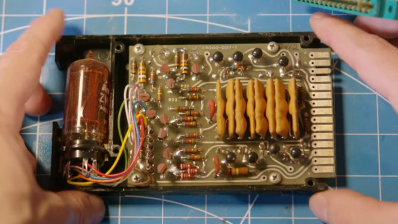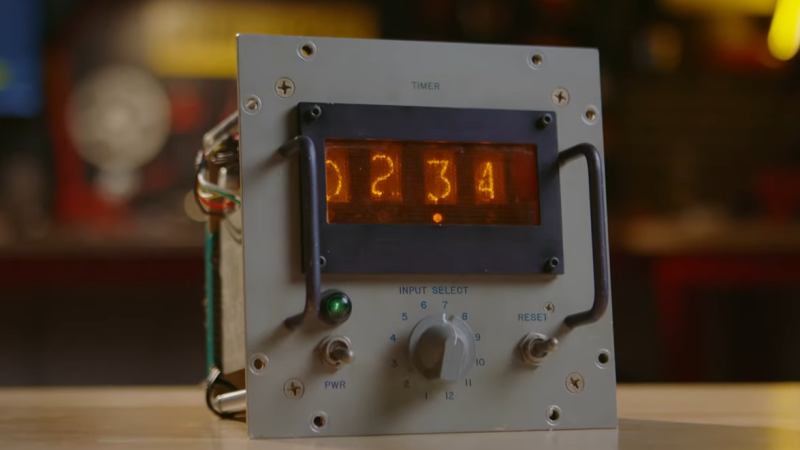Sometimes you find something that looks really cool but doesn’t work, but that’s an opportunity to give it a new life. That was the case when [Davis DeWitt] got his hands on a weird Soviet-era box with four original Nixie tubes inside. He tears the unit down, shows off the engineering that went into it and explains what it took to give the unit a new life as a clock.

A lot can happen over decades of neglect. That was clear when [Davis] discovered every single bolt had seized in place and had to be carefully drilled out. But Nixie tubes don’t really go bad, so he was hopeful that the process would pay off.
The unit is a modular display of some kind, clearly meant to plug into a larger assembly. Inside the unit, each digit is housed in its own modular plug with a single Nixie tube at the front, a small neon bulb for a decimal point, and a bunch of internal electronics. Bringing up the rear is a card edge connector.
Continues after the break…
Nixie tubes require around 170 V to light up, and they usually have a single anode and ten cathodes, one for each digit. There are modern driver boards that make Nixie projects a snap, but [Davis] discovered this unusual device had dual-anode tubes. In a dual-anode tube, each cathode — there are five in all, not ten — connects to two digits each. Which of the two lights up is determined by which anode is active. One anode connects to the even numbers, and one to the odd numbers. [Davis] ended up swapping the tubes for single-anode versions and putting the original dual-anode versions somewhere safe.
The result is a sturdy piece of computing history (like other Soviet-era display components we have seen) whose original purpose might be lost, but has gained a new life as a functional clock. You can watch [Davis] walk through the whole process in the video embedded just under the page break.

















I’m surprised that a Soviet timer would have English on the face plate.
Maybe stolen from the detonator circuit of a US nuke :)
The original tubes seem to be Amperex ZM1030, made in Holland (a NATO county). They are then swapped out for Soviet ones…
countRy
And a first search shows: ‘The ZM1030 was manufactured by different comapnies and there is also a clear glass version, the ZM1032. The B5025 is very smiliar’ (switch the Browser settings to world wide)
Cheeky Breeki: https://www.youtube.com/watch?v=IIqr94NDeTE
postscriptum: The Neatherland are the country and Holland is a part of it. ;-)
AFAIK the ZM1030 was only made by Philips in NL. Like all Philips tubes, they were sold in other countries with the brands of the local Philips subsidiaries. (Valvo, Dario, Mullard, Amperex, just to name a few).
btw: the counter modules seem to be of Western Europe or even West German origin. Driver transistors from Telefunken, counter transistors from Fairchild and resistors from Vitrohm and Beyschlag. The modules were probably exported without tubes as an unfinished product and the tubes were fitted in the destination country. A common practice back then to save a lot on import duties.
It’s sad to see such things. Guy acquires an industrial or military 4-digit counter, cannot figure out how the modules work, finds no way to drive quibinary indicators, rips out all electronic parts and replaces them with modern stuff. Worst of all, he probably gets paid for doing this.
True.
The guy has shown his bad personality.
First respect the work of the mfg / makers
Second get to know how it works.
Third Find and fix failure.
Fourth Develop the power supply, external controls.
IF there was a need to make a clock, the most of the time well documented standardized soviet units could be configure for running countind module 6, i guess.
BZW: Had muted the sound, nevertheless the body alnguage told ME, this guy is one of the egoistical overly loving themself kind of amiracanos f*** the whole world
I mean, it’s his stuff to do with as he pleases. If he wanted to douse it in kerosene and light it aflame, that would be his prerogative.
I’m sure there is a channel like that on yt. Imagine something and there is a channel for it.
His property, his time. If you don’t like that put in an offer to buy it from him. Otherwise touch grass.
God forbid a man does what he wants with his own time and property! No, the great hartl should get a vote first!!!
Of course he can do with his stuff whatever he wants, but it still offends older engineers who know how these things really work.
I made a clock with ZM1030 “biquinary” tubes. The nice thing about those tubes is they fit in standard audio tube sockets due to their internal multiplexing arrangement requiring fewer pins.
The fact he scrapped the original tubes because he couldn’t be bothered to figure out how to drive them is really sad.
Youtube is 20x worse than people used to think television was. Tiktok is just a straight up blatant infoweapon.
So the only retained part is the metalwork.
Also perhaps misleading to call it “Soviet era” when it’s clearly *not* of Soviet origin.